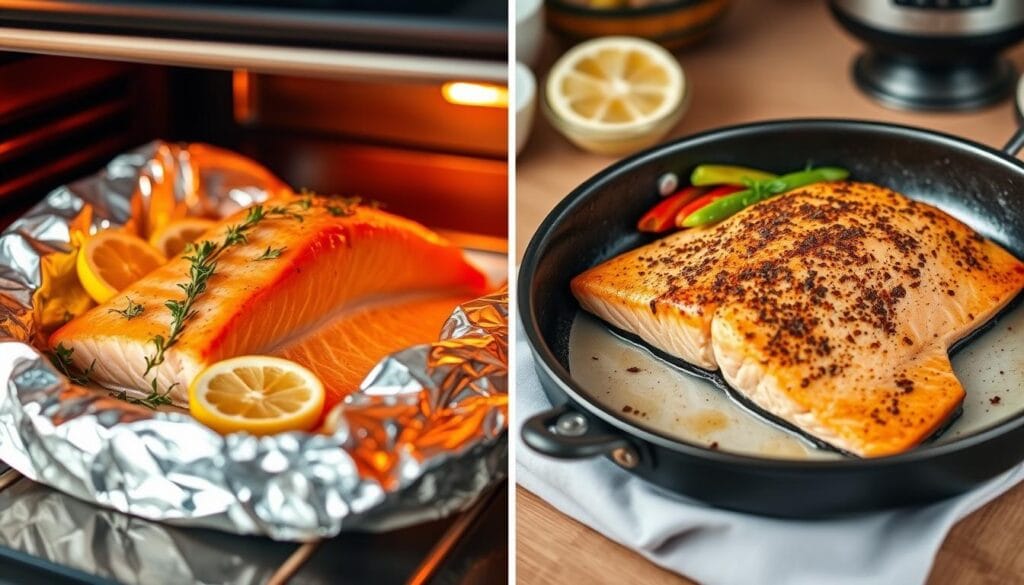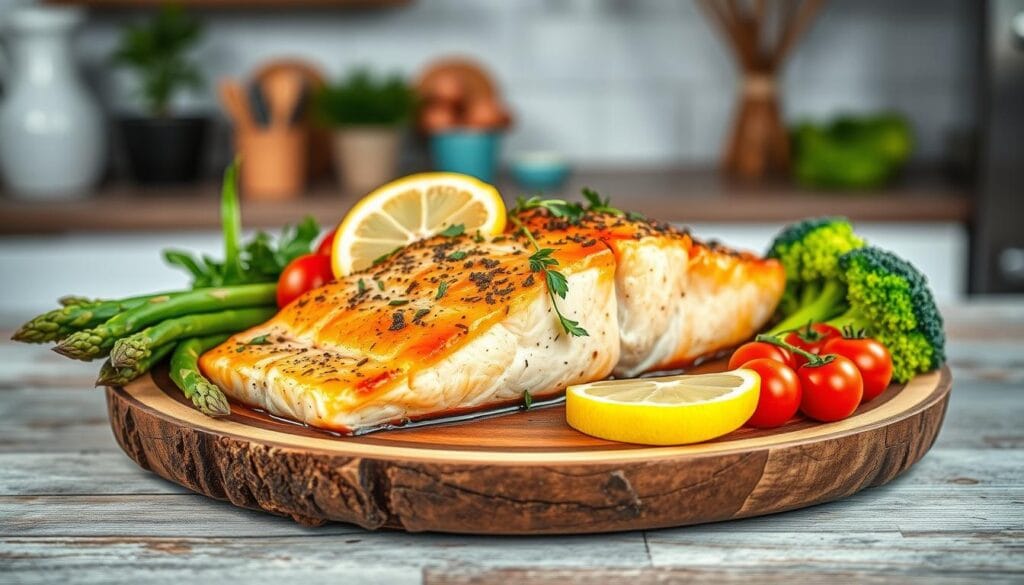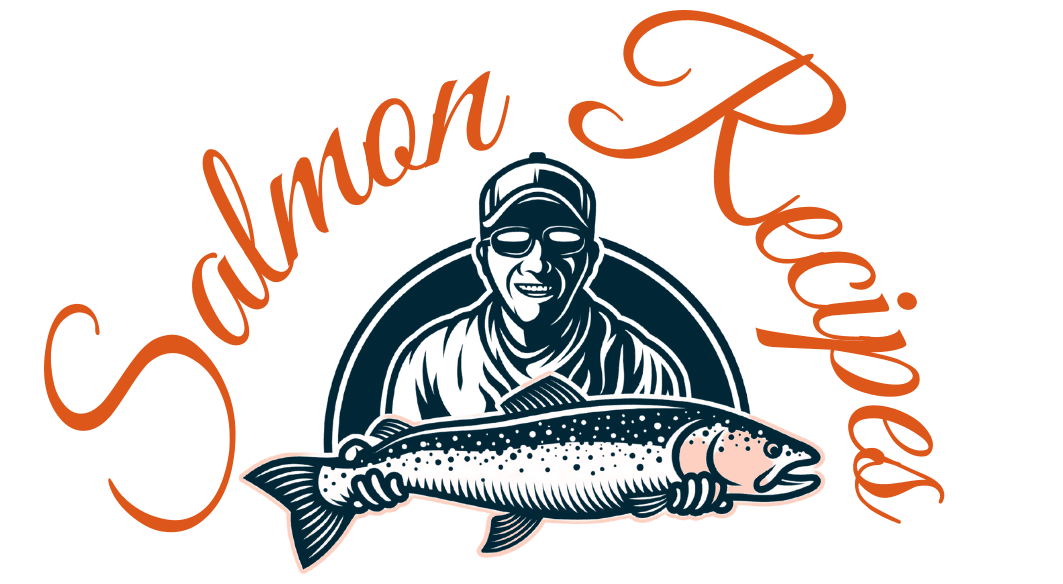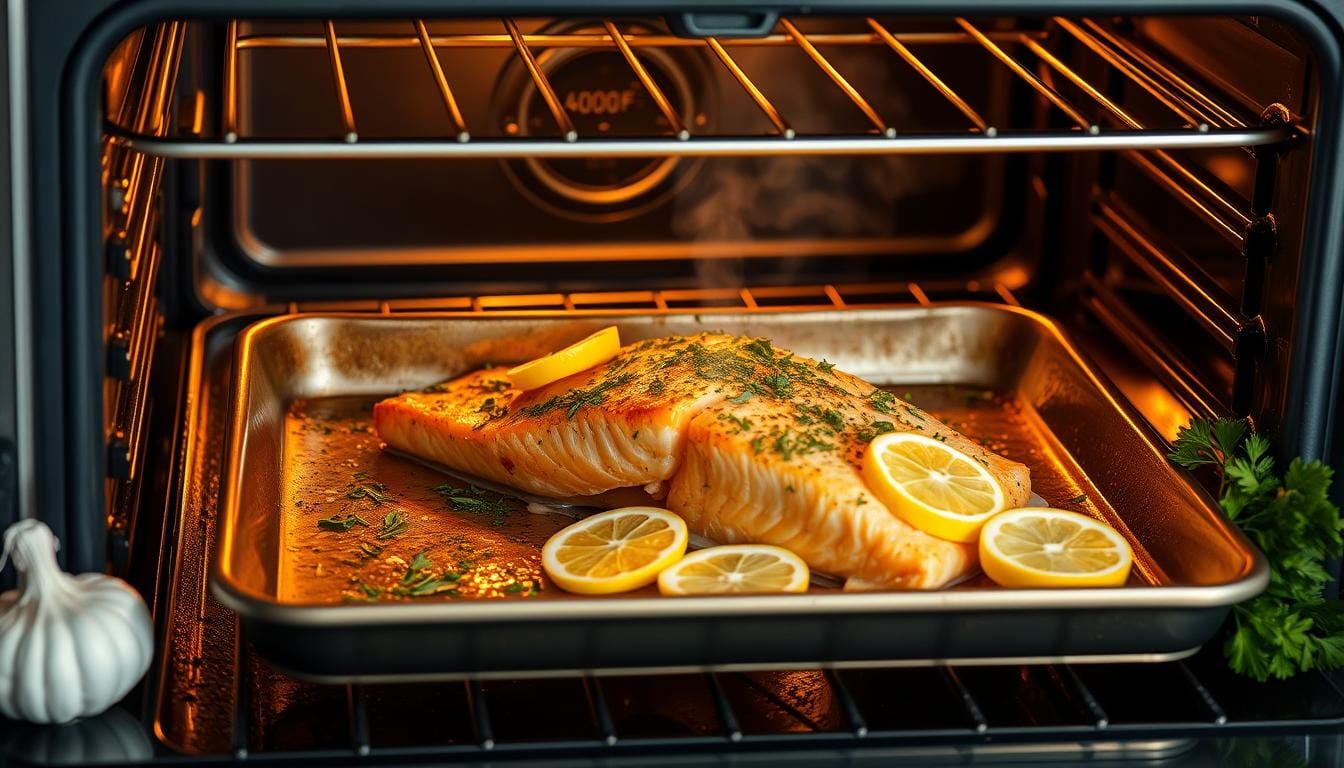Table of Contents
Learning to bake salmon at 400°F can make any meal special. Knowing how long to bake it is key to getting it just right. You want it to be moist, flavorful, and perfectly cooked.
The best baking time for salmon is between 15 to 18 minutes. This depends on how thick your fillet is. Chefs say to watch it closely to get the right temperature and texture.
The baking time changes based on the salmon’s size and thickness. A 1-pound fillet usually needs 12 to 18 minutes in a 400°F oven. The goal is to keep it moist and get a golden-brown outside that brings out the salmon’s taste.
It’s important to control the temperature when cooking salmon. The USDA says it should be 145°F inside to be safe and tasty. This way, your salmon stays tender and juicy.
Whether you’re cooking at home or aiming to be a chef, mastering salmon baking is a skill. It makes your meals healthy and delicious, impressing everyone who tries it.
Understanding the Perfect Temperature for Baking Salmon
Getting the right salmon baking temperature is key for a tasty and healthy meal. The perfect temperature affects the salmon’s texture, taste, and overall enjoyment.
Choosing the best salmon baking temperature is important. Most chefs agree that 400°F is the best temperature for perfect results.
Why 400°F Works Best for Salmon
The 400°F temperature has many benefits for cooking salmon:
- Reduces the risk of overcooking
- Helps preserve moisture in the fish
- Creates a perfectly tender texture
- Allows for even heat distribution
Temperature’s Impact on Texture and Flavor
Different temperatures result in different salmon textures and flavors:
| Temperature Range | Doneness Level | Texture Description |
|---|---|---|
| Less than 120°F | Rare | Very soft, almost raw |
| 125°F-130°F | Medium-Rare | Silky and tender |
| 135°F-140°F | Medium | Recommended, flaky and moist |
| 145°F or higher | Well-Done | Firmer, potentially drier |
Using a Meat Thermometer for Accuracy
A meat thermometer is essential for precise salmon baking. Aim for an internal temperature of 135°F for perfectly cooked salmon. This ensures food safety and keeps the salmon moist and flavorful.
“Cooking is about precision, specially with delicate proteins like salmon.” – Professional Chef
A 4-ounce salmon fillet usually takes 10-15 minutes at 400°F to cook perfectly. Thicker fillets might need up to 20 minutes to cook through.
Essential Preparation Steps for Baking Salmon
Getting your salmon ready for baking is key to making it delicious. Before you bake it in the oven, follow some important steps. These steps will help you cook the fish perfectly.
First, pick high-quality salmon fillets. Choose fish that’s fresh, has a bright color, and feels firm. Once you have your salmon, here’s what to do next:
- Thaw frozen salmon safely in the refrigerator overnight
- Pat the salmon dry with paper towels to remove excess moisture
- Let the salmon rest at room temperature for 15-30 minutes before baking
- Remove any pin bones using tweezers
“Proper preparation is the secret to perfectly baked salmon.” – Professional Chef
Tempering your salmon is very important. Letting it come to room temperature helps it cook evenly. This way, the outside won’t get too hard before the inside is cooked right. A quick pat-dry also helps make the outside crispy when you bake it.
| Preparation Step | Time Required | Purpose |
|---|---|---|
| Thawing | 8-12 hours | Ensure even temperature |
| Room Temperature Rest | 15-30 minutes | Promote even cooking |
| Pat Dry | 2-3 minutes | Create crispy exterior |
Pro tip: Use a lined baking sheet with parchment paper or a silicone mat. This prevents sticking and makes cleaning up easier. Your salmon will be ready for a great baking experience.
How Long to Bake Salmon at 400
Learning to cook salmon at 400 degrees is all about timing and detail. The thickness of your salmon fillet is key to getting it just right. Knowing this will help you cook salmon that’s moist, flavorful, and perfect every time.
When baking salmon at 400 degrees, the cooking time changes based on the fillet’s thickness. Here’s a detailed guide to help you cook salmon to perfection:
Thin Fillets (½ inch)
Thin salmon fillets cook quickly at 400 degrees. They usually need:
- 8-10 minutes total cooking time
- Keep an eye on them to avoid overcooking
- They should reach an internal temperature of 120-130°F for medium-rare
Medium Fillets (1 inch)
Medium-thickness salmon fillets take a bit longer to cook at 400 degrees. Here’s what to do:
- 12-15 minutes of total baking time
- Check for doneness around the 12-minute mark
- Aim for an internal temperature of 135-140°F
Thick Fillets (1½ inches)
Thick salmon cuts need the longest cooking time at 400 degrees. Keep these tips in mind:
- 18-20 minutes total baking time
- Use a meat thermometer to ensure proper cooking
- Verify internal temperature reaches 145°F
“The key to perfect salmon is paying attention to its thickness and monitoring the internal temperature.”
Remember, these times are just guidelines. Your actual cooking time may vary based on your oven and the salmon’s starting temperature. Always use a meat thermometer for the most accurate results.
Different Types of Salmon and Their Cooking Times
When you’re baking salmon at 400°F, knowing the different types can make a big difference. Each type of salmon has its own special traits. These traits affect how you bake the salmon fillet at 400°F.
Salmon comes in many tasty varieties, each needing different cooking methods:
- Chinook (King) Salmon: Has the most fat, making it easy to bake
- Sockeye Salmon: Leaner, needs careful cooking to stay moist
- Atlantic Salmon: Farm-raised, has a consistent texture, great for beginners
- Coho Salmon: Medium fat, works well for many cooking styles
Cooking times can change based on the salmon type and thickness. Here’s a quick guide for baking salmon at 400°F:
| Salmon Type | Thickness | Cooking Time |
|---|---|---|
| Chinook | 1 inch | 12-14 minutes |
| Sockeye | ½ inch | 8-10 minutes |
| Atlantic | 1½ inches | 14-16 minutes |
| Coho | 1 inch | 10-12 minutes |
“The key to perfect salmon is understanding its unique characteristics and adjusting cooking time.” – Professional Chef
Wild-caught salmon cooks faster because it has less fat than farm-raised. Always check the salmon’s internal temperature with a meat thermometer. It should reach 145°F for safety.
Seasoning Your Salmon for the Best Results
Learning how to season salmon is key to baking it perfectly. The right seasonings can turn a simple meal into a masterpiece. This is true for a salmon recipe bake at 400°F.
Don’t just use salt and pepper. The secret to a great dish is choosing the right herbs, spices, and fats.
Basic Seasonings and Marinades
Here are some easy yet tasty seasoning options:
- Olive oil and fresh lemon juice
- Garlic powder and black pepper
- Salt with dried dill
- Simple soy sauce marinade
Herb and Spice Combinations
Try these flavor-rich combinations for your salmon:
- Mediterranean Style: Rosemary, thyme, and oregano
- Asian-Inspired: Ginger, sesame, and green onions
- Cajun Kick: Paprika, cayenne, and garlic
Oil and Butter Options
Choosing the right fat is crucial for flavor and texture:
- Extra virgin olive oil for heart-healthy option
- Melted butter for rich, creamy taste
- Coconut oil for subtle sweetness
“The secret to perfect salmon is not just in cooking, but in the thoughtful seasoning that brings out its natural flavors.”
Pro tip: Always pat your salmon dry before seasoning. This helps the seasonings stick and creates a perfect crust when baked at 400°F.
Baking Methods: Foil vs. Open Pan

When baking salmon in the oven, you can choose between foil or an open pan. Each method has its own benefits for cooking your salmon at 400°F.
Foil Baking Method
Baking salmon in foil keeps it moist and flavorful. It’s great for making your salmon tender and preventing it from drying out.
- Cooking time: 12-20 minutes at 400°F
- Moisture retention: Excellent
- Ideal for delicate fish varieties
Open Pan Baking Method
Cooking salmon in an open pan gives it a crispy outside and a juicy inside. This method is perfect for those who love a bit of crunch.
- Cooking time: 10-15 minutes at 400°F
- Browning potential: Higher
- Better for developing caramelized edges
“The right baking method can transform your salmon from good to extraordinary.” – Professional Chef
Choosing Your Method
Your choice depends on what you like and the texture you want. Foil is best for keeping salmon moist. An open pan is great for getting those caramelized flavors.
| Method | Moisture | Cooking Time | Texture |
|---|---|---|---|
| Foil | High | 12-20 minutes | Soft, tender |
| Open Pan | Medium | 10-15 minutes | Crisp edges |
Always use a meat thermometer to check if your salmon is cooked to 145°F. This is true for both methods.
Signs of Perfectly Cooked Salmon
Knowing when your salmon is perfectly cooked can make a big difference in your meal. Getting the right salmon cook time needs careful attention to visual, textural, and temperature signs.
Visual Indicators of Doneness
When baking salmon, look for these key visual signs:
- Salmon turns from translucent to opaque pink
- Surface appears slightly glossy and moist
- Edges begin to separate and look flaky
Texture Guidelines
The perfect salmon baking time results in a specific texture. A properly cooked salmon should:
- Flake easily with a fork
- Feel tender and moist
- Maintain a smooth, silky consistency
“The key to great salmon is not overcooking – it should practically melt in your mouth.”
Internal Temperature Checks
To ensure food safety and optimal taste, use a meat thermometer. The ideal temperature for perfectly cooked salmon is 135°F. This is when measured at the thickest part of the fillet.
Pro tip: Let your salmon rest for 5 minutes after cooking. This allows the juices to redistribute, ensuring maximum flavor and moisture.
Common Mistakes to Avoid When Baking Salmon
Learning to bake salmon well means knowing what not to do. Many people find it hard to cook fish just right. But, with the right steps, you can make your salmon better.
“Precision is key when baking salmon. Every minute counts!” – Professional Chef
Here are the main mistakes to steer clear of when baking salmon:
- Overcooking the Salmon: The USDA says it should be 145°F inside. But, cooking it longer makes it dry and tough.
- Skipping the Meat Thermometer: Just looking at it isn’t enough to know if it’s done.
- Neglecting to Pat Dry: If it’s wet, you won’t get a nice crispy outside.
- Forgetting to Season Properly: If it’s not seasoned, it won’t taste good.
Getting it right starts with preparation. Here are key tips for baking salmon well:
- Always preheat your oven to the correct temperature (400°F is ideal)
- Use a meat thermometer to check internal temperature
- Let salmon rest for 3-5 minutes after cooking
- Choose fresh, high-quality fish
| Mistake | Consequence | Solution |
|---|---|---|
| Overcooking | Dry, tough texture | Use thermometer, cook to 135°F |
| Incorrect Temperature | Uneven cooking | Maintain steady 400°F |
| No Seasoning | Bland flavor | Use salt, pepper, herbs |
The baking time for salmon depends on how thick the fillet is. An 8-ounce fillet takes 12-14 minutes at 400°F. Remember, the more you practice, the better you’ll get!
Health Benefits of Properly Cooked Salmon

Baking salmon at 400°F is more than just cooking a meal. It unlocks a wealth of nutritional benefits. Salmon is a superfood that offers many health advantages when cooked right.
A 3-ounce serving of salmon is packed with nutritional value:
- 23 grams of high-quality protein
- 133 calories
- 158% Daily Value of Vitamin B12
- 71% Daily Value of Vitamin D
Baking salmon fillet at 400°F keeps its nutrients and texture perfect. The right baking temperature ensures important health-boosting compounds stay intact.
“Salmon is nature’s multivitamin, packed with nutrients that support overall wellness” – Nutrition Experts
Salmon offers several health benefits:
- Heart Health: Omega-3 fatty acids reduce inflammation and lower cholesterol
- Brain Function: Essential nutrients support cognitive performance
- Skin Quality: Vitamins and minerals promote healthy skin
Knowing how to cook salmon properly and at the right temperature can enhance these health benefits. Enjoying every bite becomes a way to boost your health.
Tips for Selecting Fresh Salmon
Choosing the right salmon is key for a great salmon recipe bake at 400 degrees. The right fish can make your dish unforgettable. So, it’s important to know how to pick the best.
Farm-Raised vs. Wild-Caught Salmon
The salmon market has two main types: farm-raised and wild-caught. Each has its own special qualities for your dish:
- Farm-Raised Salmon: It’s usually fattier and more even in size
- Wild-Caught Salmon: It’s leaner and has a more complex taste
In the United States, there are five main salmon types: Sockeye, King (Chinook), Pink, Chum, and Coho. King salmon, with its high fat, is perfect for baking at 400 degrees.
Color and Texture Indicators
When picking salmon, look for these freshness signs:
- Bright, vibrant color without any discoloration
- Firm flesh that springs back when pressed
- Little to no fishy smell
“Fresh salmon should look like it just jumped out of the water!” – Seafood Experts
Seasonal Considerations
Salmon is available at different times of the year. Wild salmon is at its peak from May to September. This is when you can get the freshest salmon for your baked recipe.
Pro tip: Buy salmon from trusted fishmongers or seafood markets for the best quality.
Storage and Reheating Guidelines
Proper storage is key after baking salmon in the oven. It keeps the flavor and ensures safety. You can store your salmon in the fridge for 3-4 days in an airtight container. The time it takes to cook and how you prepare it affects how long it can be stored.
- Cool salmon to room temperature within 2 hours of cooking
- Place in a glass or plastic airtight container
- Refrigerate immediately at or below 40°F
- Consume within 3-4 days for optimal taste and safety
Freezing is another way to store salmon for longer. You can freeze it for up to 3 months in freezer-safe packaging. Pro tip: Use plastic wrap followed by a freezer bag to prevent freezer burn.
“Proper storage is the secret to maintaining salmon’s delicate flavor and texture.” – Culinary Expert
When reheating, be gentle to avoid drying out the salmon. Here are some good methods:
- Oven method: Preheat to 275°F, cover with foil, heat for 10-15 minutes
- Air fryer: 3 minutes at 325°F
- Microwave: Short 30-second intervals, checking frequently
| Storage Method | Duration | Temperature |
|---|---|---|
| Refrigerator | 3-4 days | Below 40°F |
| Freezer | Up to 3 months | 0°F or below |
Always check for spoilage before eating stored salmon. If it smells bad, looks off, or feels slimy, throw it away.
Conclusion
Learning to bake salmon is an art that needs timing, temperature control, and skill. Knowing how long to bake salmon at 400°F lets you make dishes like a pro. The ideal baking time is usually 12-15 minutes, based on the fish’s thickness and how done you like it.
But cooking time is just the start. Choose the best fish, season it well, and check its internal temperature. It should be 145°F for safety and taste. Whether it’s a quick dinner or a special meal, getting these techniques right will make your salmon better.
Try new seasonings, baking ways, and times to find your own salmon recipe. Each try gets you closer to perfecting your salmon. Be patient, trust yourself, and enjoy the tasty outcome of your cooking adventures.
FAQ
How long should I bake salmon at 400°F?
The baking time varies based on the salmon’s thickness. For a ½-inch thick fillet, bake for 8-10 minutes. A 1-inch thick fillet needs 12-15 minutes, and a 1½-inch thick fillet may take 15-18 minutes. Always check the internal temperature with a meat thermometer to ensure it reaches 145°F for perfectly cooked salmon.
Should I cover the salmon with foil when baking?
You can bake salmon with or without foil. Foil helps keep moisture in, giving a steamed effect. An open pan allows for browning and caramelization. Both methods can result in delicious salmon, depending on your preference and recipe.
How do I know when salmon is fully cooked?
Check for several signs of doneness. The salmon should be opaque and flake easily with a fork. The internal temperature should be 145°F, and the flesh should separate at the thickest part. The color should change to light pink or coral, and the texture should be moist but firm.
What’s the best way to season salmon before baking?
Start by patting the salmon dry and seasoning with salt and pepper. Use olive oil, lemon juice, garlic, and herbs like dill or parsley for simple marinades. For more complex flavors, try herbs, spices, citrus zest, or a light glaze with honey or soy sauce.
Can I bake frozen salmon directly from the freezer?
While thawing in the refrigerator overnight is best, you can bake frozen salmon. Increase cooking time by about 50% and ensure it reaches 145°F. For even cooking, consider partially thawing the salmon before baking.
How do I prevent my salmon from drying out?
To keep salmon moist, avoid overcooking and use a meat thermometer. Bring the fish to room temperature before baking. Consider using foil or a light marinade. Remove the salmon from the oven when it’s just cooked through and let it rest for a few minutes before serving.
What’s the difference between wild-caught and farm-raised salmon?
Wild-caught salmon has a more robust flavor and is leaner. Farm-raised salmon is fattier and milder. Wild-caught salmon is often considered more nutritious and sustainable. Farm-raised salmon is more consistently available and may be more budget-friendly.
How long can I store baked salmon in the refrigerator?
Properly stored baked salmon can last 3-4 days in the refrigerator. Store it in an airtight container and cool it to room temperature before refrigerating. When reheating, use low heat in the oven or microwave with a damp paper towel to prevent drying out.

